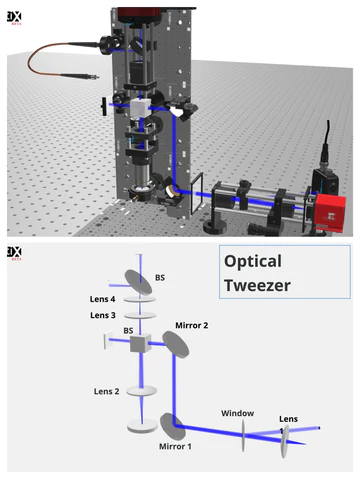Converting Linear to Circular Polarization: The Power of the Fresnel Rhomb in Modern Optics
Fresnel Rhomb Retarders: Fundamental Aspects
The Fresnel Rhomb, an uncoated optical element, functions as an exceptional phase retarder due to its unique ability to induce a phase shift between orthogonally polarized components of incident light. This phase shift modifies the polarization state of incident light, paving the way for a variety of optical phenomena and applications.
The Fresnel Rhomb operates by taking advantage of total internal reflection and resembling a compact prism. When a wave of linearly polarized light collides with the Fresnel Rhomb, the light undergoes two internal reflections within the Rhomb’s structure. During this process, the initial phase of the light is altered due to its interaction with the Rhomb’s material. This shift can be precisely a quarter-wavelength λ/4, which converts linearly polarized light to circularly polarized light, or precisely half-wavelength λ/2, which converts light to elliptically polarized light. This ability to manipulate the polarization state is one of the defining characteristics of the Fresnel Rhomb, which enables it to play a crucial role in a vast array of optical applications.
The low wavelength sensitivity of the Fresnel-Rhomb retarder is one of its distinguishing characteristics. This means that the material can effectively maintain its phase retardation properties across a broad spectrum of wavelengths, making it ideally suited for multi-wavelength applications and broadband light sources. It retains its efficacy across a wide spectrum of frequencies, demonstrating its durability and adaptability in dealing with various light sources.
Moreover, the Fresnel Rhomb retarder is not affected by birefringence, an optical effect that frequently affects other optical components and causes a light ray to divide into two rays. The Fresnel Rhomb’s resistance to birefringence enhances its dependability and desirability in the optics domain, where birefringence can frequently introduce defects and reduce an optical device’s efficiency.
Due to its phase retardation capability, low wavelength sensitivity, and birefringence resistance, the Fresnel Rhomb is a fundamental component of contemporary optics. Its exceptional properties and performance make it an indispensable instrument for modifying the path of light from its linearly polarized state to its circularly or elliptically polarized state.
3DOptix: Aiding in the Selection of Optimal Fresnel Rhomb Retarders
The task of choosing the appropriate retarder for a specific application can be intricate, considering the variety of parameters involved. Here, optical simulation software like 3DOptix proves to be a potent tool.
3DOptix is a comprehensive, cloud-based platform that integrates optics and photonics design, simulation, and analysis. It offers a state-of-the-art environment to optimize and simulate optical components, including Fresnel Rhomb retarders.
Firstly, 3DOptix allows users to simulate various parameters like incident angle, wavelength, and phase shift for different Fresnel Rhombs. By doing so, it provides a valuable understanding of how the retarder would perform under different conditions, allowing scientists to identify the ideal retarder for their specific needs.
Additionally, the software permits users to model the entire optical setup. This aspect is particularly useful in applications where Fresnel Rhombs are part of larger optical systems, as it enables the consideration of system-level effects on retarder performance.
Finally, 3DOptix also provides a toolset for simulating and optimizing the retarders in an environment that closely mimics real-world scenarios. This capacity enables users to anticipate potential issues and adjust before the actual implementation, saving both time and resources.
The Ongoing Role of Fresnel Rhomb Retarders in Modern Optics
Despite their invention in the 19th century, Fresnel Rhomb retarders continue to hold an influential role in modern optics. They are vital components of numerous optical instruments like spectropolarimeters, ellipsometers, and even advanced quantum optics apparatus. Moreover, with ongoing developments in optical technology, Fresnel Rhombs are anticipated to be increasingly employed in broadband and multi-wavelength systems.
Importantly, the evolution of software platforms like 3DOptix is making the implementation of these retarders more efficient and precise. By allowing scientists to simulate, optimize, and understand these components better, these tools are augmenting the power of Fresnel Rhomb retarders and driving their utilization in pioneering optical technologies.
Q&A section
Q1: What is the primary function of the Fresnel Rhomb in optics?
A1: In optics, the Fresnel Rhomb acts as a phase retarder. Its primary function is to induce a phase shift in the orthogonal polarization components of the incident light, altering the polarization state of the light.
Q2: How does the Fresnel Rhomb operate?
A2: The Fresnel Rhomb functions on the basis of total internal reflection. A linearly polarized light wave encountering the Rhomb undergoes two internal reflections within the Rhomb’s structure.
Q3: What phase shift does the Fresnel Rhomb introduce and what is the result of this phase shift?
A3: The Fresnel Rhomb introduces a precise phase shift of either a quarter-wavelength (λ/4) or half-wavelength (λ/2). This phase shift transforms linearly polarized light into circularly or elliptically polarized light, respectively.
Q4: What makes the Fresnel Rhomb suitable for multi-wavelength applications and broadband light sources?
A4: The low wavelength sensitivity of the Fresnel Rhomb makes it effective across a broad spectrum of wavelengths. This quality makes it suitable for multi-wavelength applications and broad-spectrum light sources.
Q5: How does the Fresnel Rhomb handle the issue of birefringence?
A5: In contrast to many other optical components, the Fresnel Rhomb is unaffected by birefringence. This indicates that it does not split a light ray into two rays, a problem that frequently reduces the efficacy of other optical devices. This immunity increases the Fresnel Rhomb’s dependability and desirability in optical applications.










